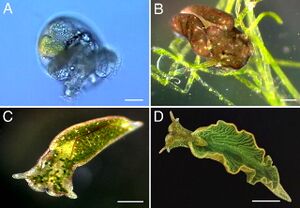Elysia chlorotica: Difference between revisions
No edit summary |
|||
| Line 4: | Line 4: | ||
[[File:Elysia chlorotica stages.jpg|thumb|300px|right|Development stages of <i>Elysia chlorotica</i>]] | [[File:Elysia chlorotica stages.jpg|thumb|300px|right|Development stages of <i>Elysia chlorotica</i>]] | ||
<i>Elysia chlorotica</i> is | <i>Elysia chlorotica</i> is small sized sea slug. The adult individual are around 3~5 centimeters long. An <i>Elysia chlorotica</i> has two stages of development: juvenile and adult stages, which can be distinguish by its morphology and coloring. During juvenile stage, newly hatched <I>E. chlorotica</I> are usually translucent brown, with few red spots on their bodies. This stage remains until the initial feeding on algae. The <I>E. chlorotica</I> obtains chloroplast from the algae, preserving in its special digestive tract. The presence of chloroplast gradually turns the body color into bright green, and lost red spots. | ||
==Kleptoplasty== | ==Kleptoplasty== | ||
Kleptoplasty is a special symbiosis behavior that the chloroplast uptake by algal prey can remain temporarily function in the organism, which allows an animal doing photosynthesis like plants. A typical species in the clade Sacoglass | Kleptoplasty is a special symbiosis behavior that the chloroplast uptake by algal prey can remain temporarily function in the organism, which allows an animal doing photosynthesis like plants. A typical species in the clade Sacoglass | ||
Revision as of 01:41, 8 November 2021
Introduction
Elysia chlorotica is a type of sea slug that can do photosynthesis.
Life cycle
Elysia chlorotica is small sized sea slug. The adult individual are around 3~5 centimeters long. An Elysia chlorotica has two stages of development: juvenile and adult stages, which can be distinguish by its morphology and coloring. During juvenile stage, newly hatched E. chlorotica are usually translucent brown, with few red spots on their bodies. This stage remains until the initial feeding on algae. The E. chlorotica obtains chloroplast from the algae, preserving in its special digestive tract. The presence of chloroplast gradually turns the body color into bright green, and lost red spots.
Kleptoplasty
Kleptoplasty is a special symbiosis behavior that the chloroplast uptake by algal prey can remain temporarily function in the organism, which allows an animal doing photosynthesis like plants. A typical species in the clade Sacoglass
Feeding
Conclusion
References
Rumpho, M. E., J. M. Worful, J. Lee, K. Kannan, M. S. Tyler, D. Bhattacharya, A. Moustafa, and J. R. Manhart. 2008. “Horizontal Gene Transfer of the Algal Nuclear Gene PsbO to the Photosynthetic Sea Slug Elysia Chlorotica.” Proceedings of the National Academy of Sciences 105 (46): 17867–71. https://doi.org/10.1073/pnas.0804968105.

